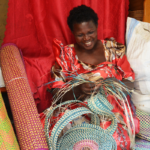In a recent post, we explained how FHI 360 has been using financial diaries to understand the economic lives of vulnerable groups. Financial diaries are a high-frequency panel data collection methodology in which participants are asked to record each of their daily financial inflows (cash and in-kind income) and outflows (expenditures) over a period of weeks or months. If you’re thinking that’s a huge amount of data, you’re right! And for good reason. The detailed data gathered using financial diaries allow us to answer a range of questions that can inform programming and future research. In this post, we describe a few ways financial diaries have been useful in our work with vulnerable groups.
Using financial diaries to benefit vulnerable groups
The main impetus for using financial diaries has been to inform economic strengthening interventions within integrated programming for the populations with which we work. If our goal is to address economic vulnerability, which has not-so-far downstream effects on health and health-seeking behavior, we must first understand the nature of that vulnerability. Do individuals lack income or financial capital? Do they have money but no plan to manage it? Can they access loans from formal institutions or do they rely on informal sources like friends and family? Financial diaries allow us to answer these questions (and more), then make informed recommendations on the most appropriate interventions to meet the needs of each group.
Using financial diaries in Malawi
As an example of how these data have been used, Lorenzetti, Swann and O’Regan (2019) used financial diaries to understand the financial lives of women in prevention of mother-to-child transmission (PMTCT) care in Malawi. We found that women in our study controlled very small amounts of cash, and their spending focused heavily on meeting basic household needs such as food. In addition, their inflows from intra-household transfers (i.e., money given to the participant from others within the household) and gifts (i.e., money given to the participant from those outside the household) accounted for more than half of their total inflows. This highlighted participants’ reliance on others to meet daily basic needs. It also gave context to the financial burden of additional expenses, such as those incurred from frequent visits to the health facility for PMTCT-related care as well as additional food costs linked to how women are counselled to care for themselves while pregnant and breastfeeding. Findings also placed a clear emphasis on women’s social networks, which we found to be a cornerstone of economic stability for pregnant women and new mothers in our study.
Based on these findings, we recommended that women be engaged in income generating activities, especially in the agricultural and fishing industries that are more prominent where they live, to empower them to earn an income and become more financially independent. We also recommended that health facility staff and local organizations create linkages between mothers in PMTCT care and village banks operating in their communities. Village banks provide not only a way for women to save their newly earned cash, borrow money to meet basic needs and bear the increased financial costs of adhering to PMTCT care, but also a social space for sharing their PMTCT experiences.
Using financial diaries in Cote d’Ivoire and Ethiopia
Economic vulnerability looks different across different populations and contexts. Where women in Malawi had little self-earned income, Namey, Perry and colleagues (2018) found in a financial diaries study with female sex workers in Abidjan, Cote d’Ivoire that women had a median weekly income higher than the weekly equivalent of per capita gross national income. However, the aggregate income figures obscure the income volatility of sex work. Many women recorded weeks with zero earned income, which can increase the potential for sexual risk-taking behavior in subsequent weeks.
In a similar financial diaries study with female sex workers in Addis Ababa, Ethiopia, Namey, O’Regan and Lorenzetti (2019) also found the median weekly income for women in the study to be high relative to national averages, but that women dedicated nearly one-fifth of their outflows to the costs of doing business, including room rentals and the purchase of substances (e.g., alcohol, chat, tobacco) that made their work life bearable.
Based on the findings from both studies with female sex workers, we recommended financial management training and secure places to save as key economic strengthening activities that can reduce income volatility and increase financial stability to, in turn, reduce HIV-related risk. The similarities across two urban areas on opposite sides of the African continent provided critical information on the core content to be included in an economic strengthening curriculum, while qualitative information collected during these studies highlighted necessary non-financial content for the curriculum (e.g., life skills, gender equity training).
Can the act of keeping a financial diary effect its own kind of change?
Although financial diaries were conceptualized as a means to an end, what if the act of keeping the diary effects its own kind of change? We found some qualitative evidence of this in Malawi, where women described that keeping the diary increased their awareness of household inflows and outflows and their food consumption patterns, such as prioritizing money for relish and protein before buying other food items. However, in such a cash-poor context, this awareness did not, or perhaps could not, translate into financial behavior changes (e.g., saving more or spending less) on a broad scale. In Malawi, we feel confident that the financial diaries served as a methodology, not an intervention, and did not skew findings.
Female sex workers in Abidjan and Addis Ababa also commented on how keeping the diary raised their awareness of how much money was coming in – and how quickly it was going out, without much to show for it. We observed no quantitative increases in savings or decreases in expenditures (as one might expect if diarists make changes in response to increased awareness of spending patterns), likely due to the short duration (six weeks) of these financial diary projects and the inconsistent nature of sex work income, but small-scale changes in decision-making or behavior are possible. However, given the potential for keeping a diary to raise awareness that could lead to measurable behavior changes, future studies should monitor this aspect of the approach.
Key points for future financial diary studies
As the development sector focuses more attention on poverty and inequality as structural risk factors, the level of detail generated by financial diaries, particularly when in combination with qualitative research to help explain the quantitative data, offers extremely useful information on the specific challenges and needs of vulnerable populations that might be addressed by integrated economic strengthening programming.
This post was produced under United States Agency for International Development (USAID) Cooperative Agreement No. AID-OAA-LA-13-00001 and was made possible by the generous support of the American people through USAID and the United States President’s Emergency Plan for AIDS Relief. The contents are the responsibility of FHI 360 and do not necessarily reflect the views of USAID or the United States Government.
Photo credit: shameersrk/pixabay



